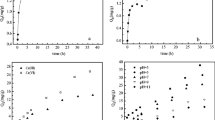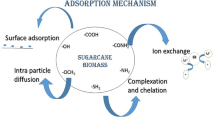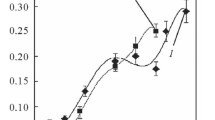Abstract
Agricultural products and by-products are now widely used for removal of hexavalent chromium from waste water. This option is more efficient and less expensive than conventional physicochemical treatments. The purpose of this study was reduction of carcinogenic hexavalent chromium to non-toxic trivalent chromium by use of aqueous extracts of sugar cane bagasse, which contains a variety of reducing components, for example sugar. The rate of this process is accelerated by use of surfactant as catalyst.







Similar content being viewed by others
References
K. Mukherjee, R. Saha, A. Ghosh, S.K. Ghosh, B. Saha, Efficient combination of promoter and catalyst for chromic acid oxidation of propan-2-ol to acetone in aqueous acid media at room temperature. Spectrochim. Acta Part A Mol. Biomol. Spectrosc. 101, 294–305 (2013)
B. Saha, C. Orvig, Biosorbents for hexavalent chromium elimination from industrial and municipal effluents. Coord. Chem. Rev. 254, 2959–2972 (2010)
R. Saha, R. Nandi, B. Saha, 14. Sources and toxicity of hexavalent chromium. J. Coord. Chem. 64, 1782–1806 (2011)
D. McAdary, N.R. Rhodes, F. Briggins, M.M. Bailey, K.R.D. Bona, C. Goodwin, J.B. Vincent, J.F. Rasco, Potential of chromium(III) picolinate for reproductive or developmental toxicity following exposure of male CD-1 mice prior to mating. Biol. Trace Elem. Res. 143, 1666–1672 (2011)
V.I. Luschak, Environmentally induced oxidative stress in aquatic animals. Aquat. Toxicol. 101, 13–30 (2011)
K.K. Krishnani, V. Parimala, X. Meng, Detoxification of hexavalent chromium from coastal water using lignocellulosic waste. Water S. Afr. 30, 541–546 (2004)
J.S. Melo, S.F. D’Souza, Removal of chromium by mucilaginous seeds of Ocimum basilicum. Bioresour. Technol. 92, 151–155 (2004)
V. Desjardin, R. Bayard, P. Lejeune, R. Gourdon, Utilisation of supernatants of pure cultures of Streptomyces thermocarboxydus NH 50 to reduce chromium toxicity and mobility in contaminated soils. Water Air Soil Pollut. 3, 153–160 (2003)
A. Baral, R.D. Engelken, Chromium based regulation and greening in metal finishing industries in the USA. Environ. Sci. Policy 5, 121–133 (2002)
S. Chakrabarti, B. Chaudhuri, S. Bhattacharjee, A.K. Ray, B.K. Dutta, Photo-reduction of hexavalent chromium in aqueous solution in the presence of zinc oxide as semiconductor catalyst. Chem. Eng. J. 153, 86–93 (2009)
G. Crini, Recent developments in polysaccharide-based materials used as adsorbents in wastewater treatment. Prog. Polym. Sci. 30, 38–70 (2005)
G.P. Haight, E. Perchonock, F. Emmenegger, G. Gordon, The mechanism of the oxidation of sulfur (IV) by chromium (VI) in acid solution. J. Am. Chem. Soc. 87, 3835–3840 (1965)
C.W. Hickey, Sensitivity of four New Zealand cladoceran species and Daphnia magna to aquatic toxicants. N. Z. J. Mar. Freshwater Res. 23, 131 (1989)
G. Mance, V.M. Brown, J. Gardiner, J. Yates, Technical Report TR 207; (Medmenham Water Research Centre, Medmenham, 1984)
T. Olmetz, The optimization of Cr(VI) reduction and removal by electrocoagulation using response surface methodology. J. Hazard. Mater. 162, 1371–1378 (2009)
M. Pettine, D. Tonnina, F.J. Millero, Chromium(VI) reduction by sulphur(IV) in aqueous solutions. Mar. Chem. 99, 31–41 (2006)
M. Rivero-Huguet, W.D. Marshall, Influence of various organic molecules on the reduction of hexavalent chromium mediated by zero-valent iron. Chemosphere 76, 1240–1248 (2009)
S.K. Sahu, P. Meshram, B.D. Pandey, V. Kumar, T.R. Mankhand, Removal of chromium(III) by cation exchange resin, Indion 790 for tannery waste treatment. Hydrometallurgy 99, 170–174 (2009)
M. Wazne, S.C. Jagupilla, D.H. Moon, S.C. Jagupilla, C. Christodoulatos, M.G. Kim, Assessment of calcium polysulfide for the remediation of hexavalent chromium in chromite ore processing residue (COPR). J. Hazard. Mater. 143, 620–628 (2007)
P. Yuan, D. Liu, M. Fan, D. Yang, R. Zhu, F. Ge, J. Zhu, H. He, Removal of hexavalent chromium [Cr(VI)] from aqueous solutions by the diatomite-supported/unsupported magnetite nanoparticles. J. Harzard. Mater. 173, 614–621 (2009)
R. Saha, K. Mukherjee, I. Saha, A. Ghosh, S.K. Ghosh, B. Saha, Removal of hexavalent chromium from water by adsorption using mosambi peel (Citrus limetta). Res. Chem. Intermed. (2012). doi:10.1007/s11164-012-0754-z
B.V. Babu, S. Gupta, Adsorption Cr(VI) using activated neem leaves: kinetic studies. Adsorption 14, 85–92 (2008)
L. Dupont, E. Guillon, Removal of hexavalent chromium with a lignocellulosic substrate Extracted from wheat bran. Environ. Sci. Technol. 37, 4235–4241 (2003)
D. Shukla, P.S. Vankar, S.K. Srivastava, Bioremediation of hexavalent chromium by a cyanobacterial mat. Appl. Water Sci. (2012). doi:10.1007/s13201-012-0044-3
S. Sarkar, A. Satheshkumar, N. Pradeepa, R. Premkumar, Hexavalent chromium (CR(VI)) removal by live mycelium of a Trichoderma Harzianum Strain. Asian J. Exp. Biol. Sci. 1, 606–613 (2010)
D. Malesev, V. Kuntic, Investigation of metal-flavonoid chelates and the determination of flavonoids via metal-flavonoid complexing reactions. J. Serb. Chem. Soc. 72, 921–939 (2007)
V.A. Okello, S. Mwilu, N. Noah, A. Zhou, J. Chong, T.K. Michael, D. Doetschman, O.A. Sadik, Reduction of hexavalent chromium using naturally-derived flavonoids. Environ. Sci. Technol. (2012). doi:10.1021/es301060q
A. Ghosh, R. Saha, K. Mukhejee, S.K. Ghosh, S. S. Bhattacharyya, S. Laskar, B. Saha, Selection of suitable combination of nonfunctional micellar catalyst and hetero-aromatic nitrogen base as promoter for chromic acid oxidation of ethanol to acetaldehyde in aqueous medium at room temperature. Int. J. Chem. Kinet. 45, 175–186 (2013)
K. Mukherjee, R. Saha, A. Ghosh, S.K. Ghosh, B. Saha, Chromium removal technologies. Res. Chem. Intermed. (2012). doi:10.1007/s11164-012-0779-3
Acknowledgments
Financial support from CSIR, New Delhi is gratefully acknowledged.
Author information
Authors and Affiliations
Corresponding author
Electronic supplementary material
Below is the link to the electronic supplementary material.
Rights and permissions
About this article
Cite this article
Mukherjee, K., Saha, R., Ghosh, A. et al. Surfactant-assisted bioremediation of hexavalent chromium by use of an aqueous extract of sugarcane bagasse. Res Chem Intermed 40, 1727–1734 (2014). https://doi.org/10.1007/s11164-013-1077-4
Received:
Accepted:
Published:
Issue Date:
DOI: https://doi.org/10.1007/s11164-013-1077-4




